集大软件工程15级结对编程week1
0. 团队成员
| 姓名 | 学号 | 博客园首页 | 码云主页 |
|---|---|---|---|
| 孙志威 | 20152112307 | Agt | Eurekaaa |
| 孙慧君 | 201521123098 | 野原泽君 | 野原泽君 |
1. 需求分析:针对现有代码的改进分析,新开发功能的分析。
1. 题目需求:
- 原题要求:
- 写一个能自动生成小学四则运算题目的命令行 “软件”:
- 除了整数以外,还要支持真分数的四则运算,真分数的运算,例如:1/6 + 1/8 = 7/24;
- 运算符为 +, −, ×, ÷;
- 并且要求能处理用户的输入,并判断对错,打分统计正确率
- 要求能处理用户输入的真分数, 如 1/2, 5/12 等;
- 使用 -n 参数控制生成题目的个数,例如执行下面命令将生成10个题目 :Myapp.exe -n 10。
- 把这个程序做成GUI:
- 记录用户的对错总数,程序退出再启动的时候,能把以前的对错数量保存并在此基础上增量计算;
- 有计时功能,能显示用户开始答题后的消耗时间;
- 界面支持中文简体/中文繁体/英语,用户可以选择一种。
- 两个任务:
- 把计算模块提取出来,单独创建一个类。
- 针对提取出来的计算类的接口函数做单元测试。
- 写一个能自动生成小学四则运算题目的命令行 “软件”:
- 功能改进与扩展:
- 增加括号操作符;
- 减少重复题目;
- 增加一个运算符(乘方):用符号 ^ 表示乘方,例如:4 ^ 2=16;
- 回归测试:在开发新功能时避免损坏旧的功能,以确保新的功能不与原有功能冲突,在确认修改的功能正确之后再嵌入代码;
- 效能分析。
2. 代码分析
- 获取代码
- 引用老师提供的代码为: 码云地址
- Clone该项目
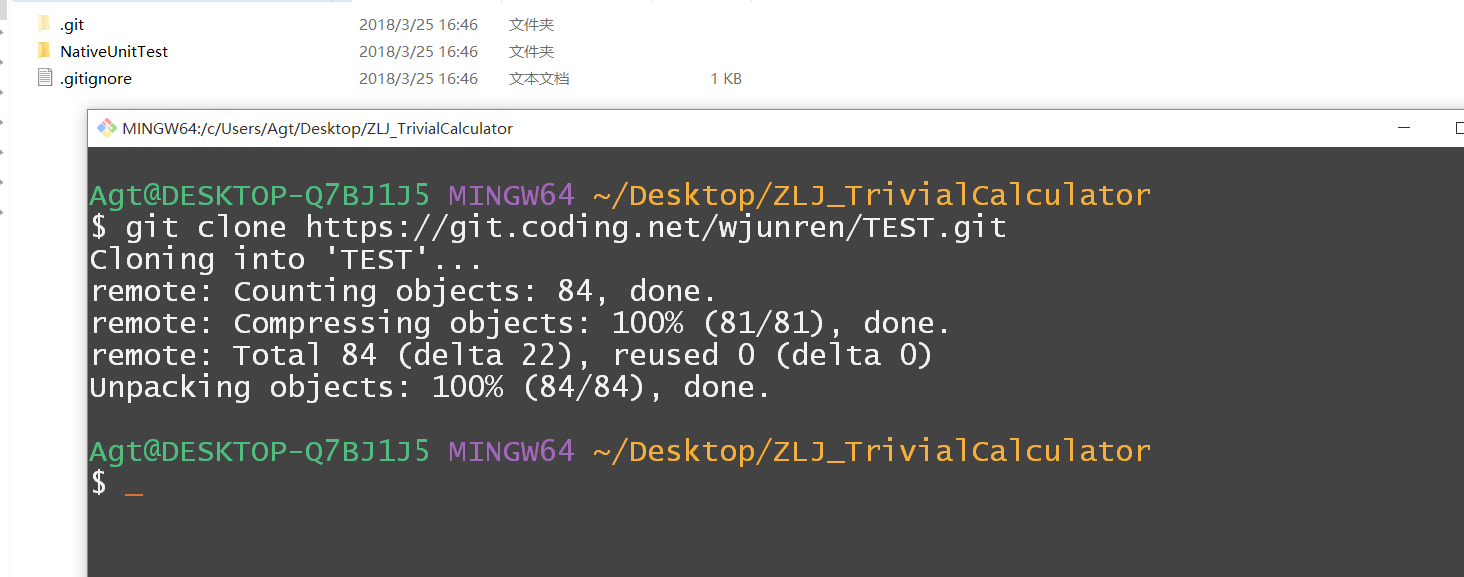
- 分析结构
-
类之间关系
比较码云的链接中给出的代码只有两个类:
TrivialCalculator 和 TrivialCalculatorTest -
类图
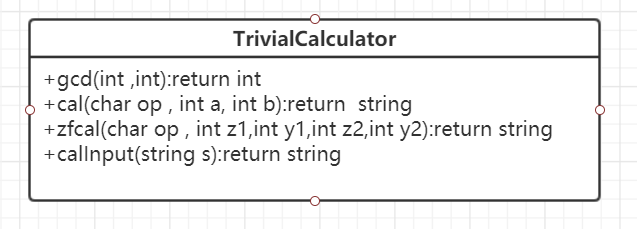
-
逻辑分析:该项目一共只有4个函数,分别为
- gcd 求出最大公约数
- cal 实现两个数字的加减乘除计算
- zfcal 实现两个分数的加减乘除
- calinput 处理输入的字符串
基本上都是逻辑清晰的分支结构,所以没有“逻辑泥球”
-
测试用例
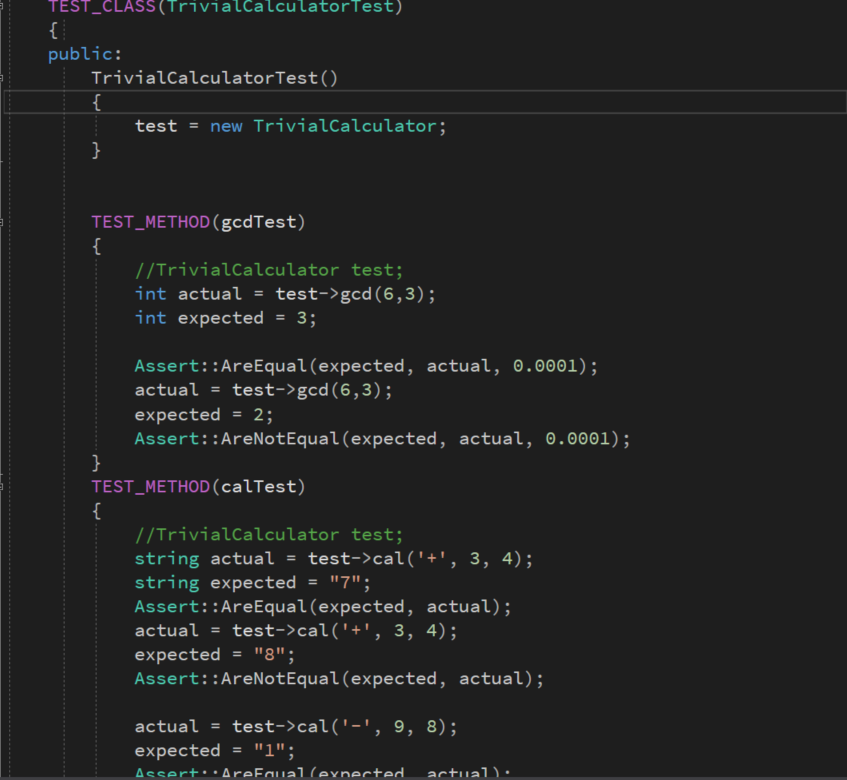
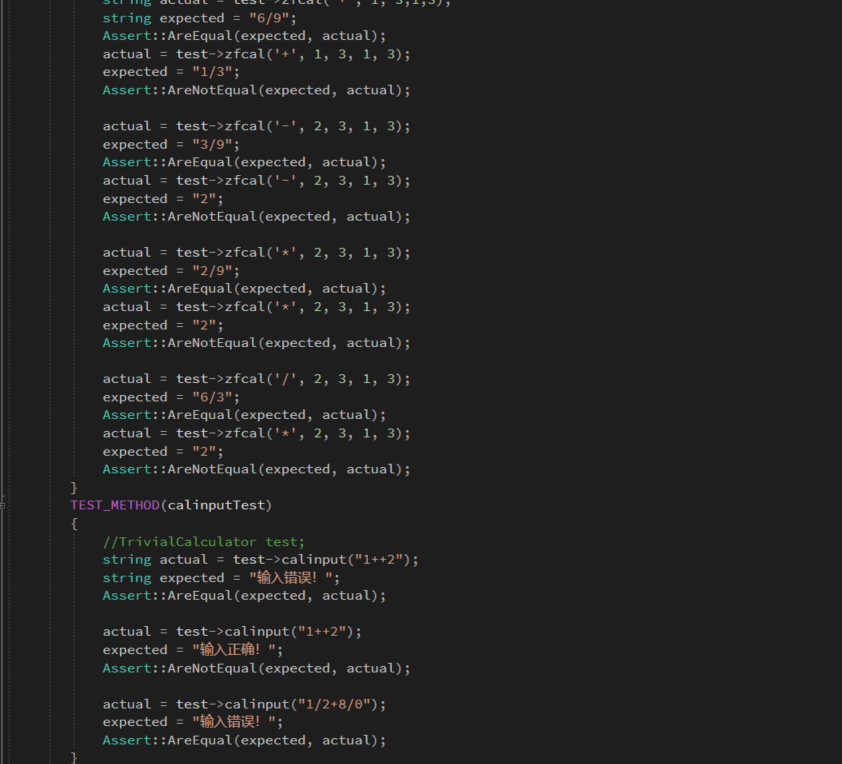
测试用例完整覆盖了所有函数的各个分支
-
分析现有代码需要改进的地方:
- 没有实现真分数和整数的同时存在:使用随机实现真分数和整数的可能同时出现。
- 没有实现表达式中数字个数的随机:利用宏定义统一设置表达式数字个数的最多个数,从2到设置的最多位数随机取一个数,决定表达式的数字长度。
【表达式的生成利用循环“随机符号+随机数字”,最终去除第一位符号来得到】 - 码云里的代码不能运行;
- GUI界面有待改善;
- 代码可读性不强,缺少相应的注释。
- 新开功能的分析:
- 添加括号:
- 表达式中数字个数大于2时,可随机添加括号;
- 左括号的添加位置可以为表达式前,或各个运算符的后面(除了最后一个运算符),右括号的添加位置可以为表达式的最后,或与左括号相隔一个符号开始到表达式最后的每个运算符的左边。
- 减少重复题目:
- 将表达式分解为多个“符号+数字”组合的数组,第一位数字前符号为“+”;
- 对组合数组进行排序,并放入二叉树,左子节点为该父节点组合在数组中的下一位,右子节点为在数组中拥有相同上几位组合的同位的不同组合;
- 每生成一个表达式就v在该二叉树内检索插入,已存在则剔除重新生成。(直说好难理解,下面会用图解释)
- 添加乘方:
- 为了减小使用者和计算机内部的计算量,将最多只添加一个二次幂或三次幂;
- 遍历表达式字符串,得到运算符的位置,并在这些位置和表达式的末尾中随机抽取一个位置,在其右边添加"^2"或 "^3"。
-
2. 程序设计:针对新开发功能做设计,建议使用思维导图。
-
程序总体设计
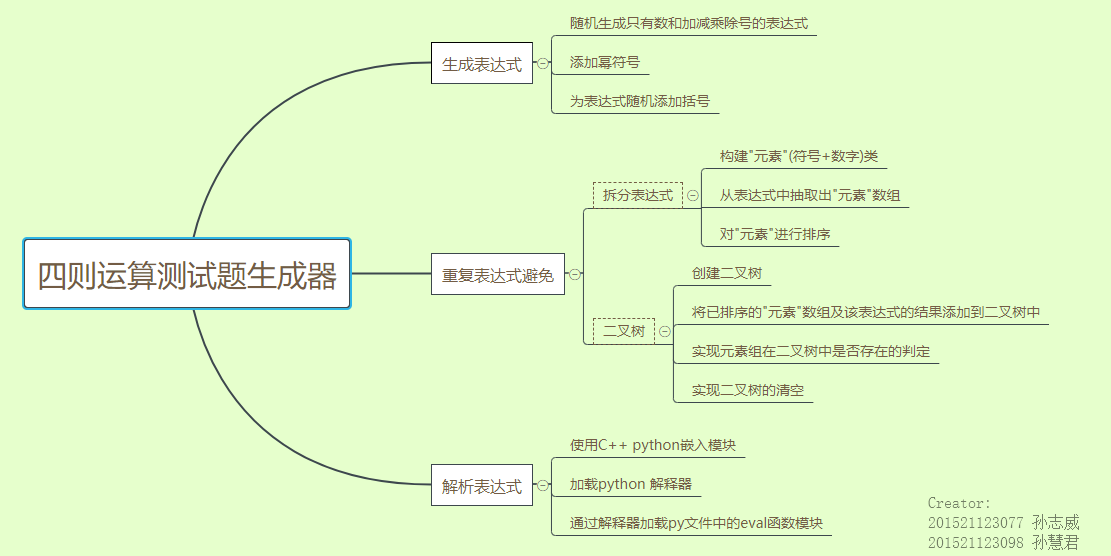
-
所使用的二叉树算法介绍
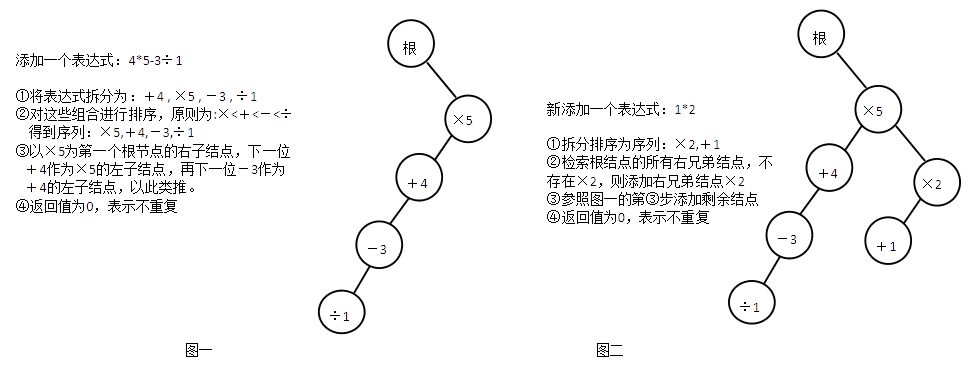
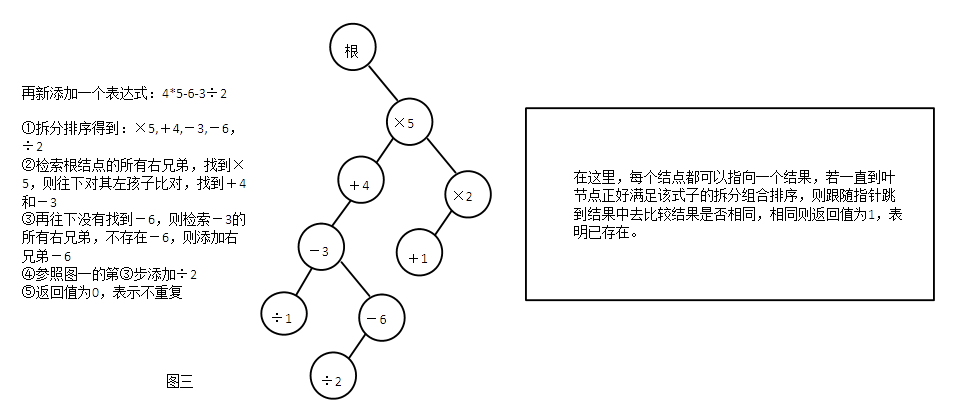
-
程序主要部分介绍(C++,C++/QT,Python,C#)
- 生成表达式(C++):采用随机产生字符拼接成字符串的方式生成
- 加工表达式(C++)
- 对生成的表达式进行合法性检查
- 在合理位置添加括号、 幂运算等操作
- 将表达式分割为以“符号+数字”的更小元素
- 将表达式以“元素”为单元进行统一排序
- 避免表达式广义重复(C++)
- 构建了一个二叉树结构用来解析排序后的表达式是否重复
- 二叉树将添加并维护存在过的所有表达式
- 解析表达式(python)
- 使用C++调用python接口
- 使用python的eval函数动态解析表达式
所以就不用正常的中缀-后缀 + 栈解析的做法了(py大法好)
- 前端显示(C++/QT)
- 用QT简单的做了个显示表达式、能检测输入框答案是否正确的GroupBox
- 然后运行时在MainWindows里new几个Box就酱
- 单元测试部分(C#)
- 单元测试用的是MS测试框架
- 测试项目不需要与正常代码放在同一项目下,‘引用’功能和测试资源管理器都十分好用
-
各新增功能演示
-
支持括号
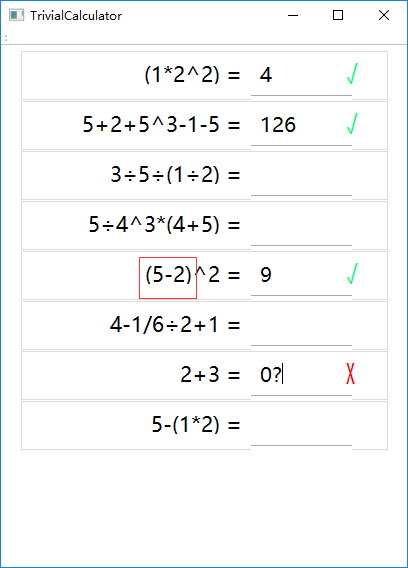
-
表达式不重复
表达式重复的几率为0,具体算法见二叉树算法处 -
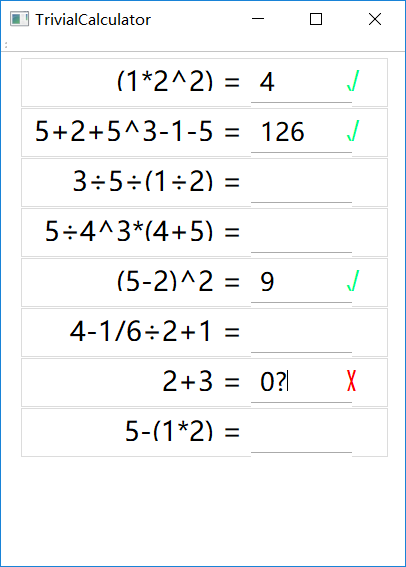

-
乘方运算
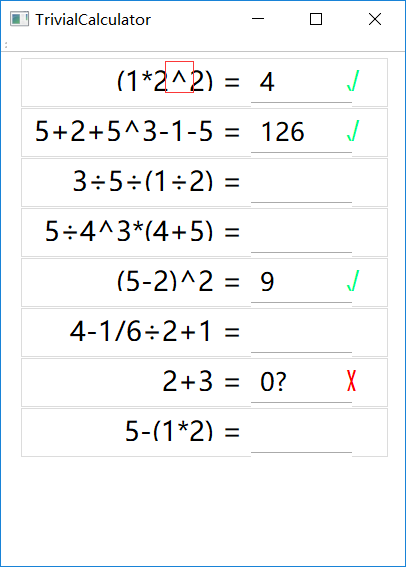
-
-
测试分析结果
-
回归测试:
测试方法大纲
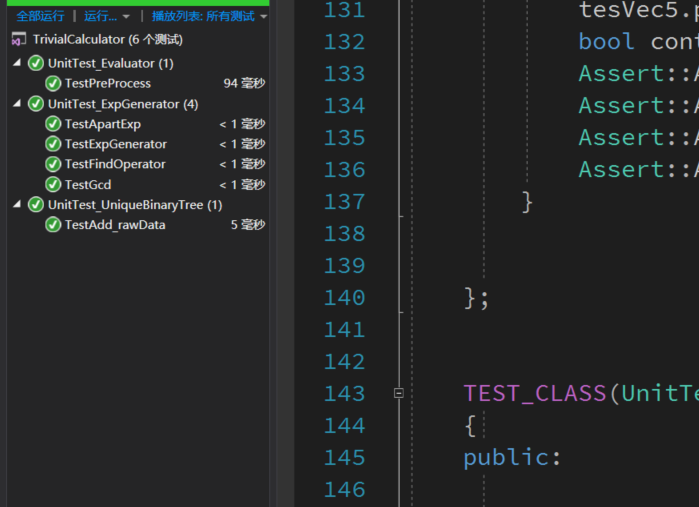
部分测试用例
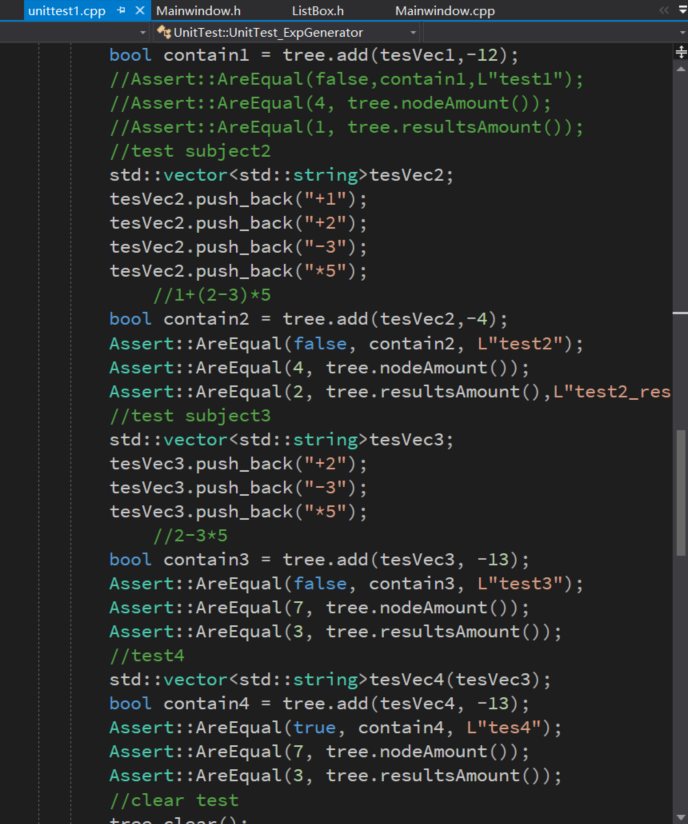
-
代码覆盖率测试

-
效能分析

-
消耗最大模块
- 发现占用绝大部分时间的都不是用户的函数
基本都是系统调用 - 但是在用户代码中有一个 Evaluator::initPython方法被调用了124次,实际上这里是可以优化的
- 优化建议:将Evaluator的一些需要全局经常调用的方法设置为static的类方法,一旦init后就不需要再调用了,可以大大减少该函数的调用次数
- 发现占用绝大部分时间的都不是用户的函数
-
3. 代码展示:展示每个功能的核心代码。
-
字符串生成类
class ExpGenerator { public: ExpGenerator(); ~ExpGenerator(); int getGcd(int x, int y); string generateRawExp(); vector<int> findOperator(string exp); string addBracket(string exp); string addPower(string exp); vector<string> apartExp(string exp); vector<string> sortExp(vector<string> items); vector<string> generate(int amount, vector<double>&results); };- 生成字符串
string ExpGenerator::generateRawExp() { //产生初始表达式 string exp = ""; char ch[5] = { '+','-','*','~','^' }; int maxNum; if (NUMBER < 2) { //表达式位数小于2则报错 exp = "ERROR!"; return exp; } else if (NUMBER == 2) maxNum = 2; else maxNum = rand() % NUMBER + 2; for (int i = 0; i < maxNum; i++) { //以(符号+数字)*maxNum形成第一位为符号的“伪表达式” //随机生成符号 char c = ch[rand() % 4]; exp.push_back(c); //随机生成数字 stringstream ss; string s; int flag = rand() % 10; if (flag != 0) //生成整数(90%) ss << rand() % MAX + 1; else { //生成分数(10%) int mumNum = rand() % MAX + 2; int sonNum = rand() % (mumNum - 1) + 1; sonNum /= getGcd(mumNum, sonNum); mumNum /= getGcd(mumNum, sonNum); ss << sonNum << "/" << mumNum; } ss >> s; exp += s; } //截去第一位符号,生成初始表达式 exp = exp.substr(1, exp.length()); ////cout << exp << endl; return exp; } - 拆分字符串并排序
vector<string>ExpGenerator::apartExp(string exp) { //遍历初始表达式,以“符号+数字”的结构分割返回 vector<string> items; int begin = 0; int end; unsigned int i; string str; exp = "+" + exp; char c; for (i = 0; i < exp.length(); i++) { c = exp.at(i); if ((c == '+' || c == '-' || c == '*' || c == '~') && (i != 0)) { end = i; str = exp.substr(begin, end - begin); items.push_back(str); begin = i; } } str = exp.substr(begin, exp.length() - begin); items.push_back(str); return items; } vector<string> ExpGenerator::sortExp(vector<string> items) { //将分割后的表达式项进行排序,用于二叉树的形成 sort(items.begin(), items.end()); return items; }
- 生成字符串
-
二叉树相关
class UniqueBinaryTree { public: UniqueBinaryTree(); ~UniqueBinaryTree(); // check if the tree contains the expression // if contains return true // else return false // and add the unique new nodes to the tree bool add(vector<string>expressionVec, double answer); // clear the tree but not destoryed it void clear(); // get amount of the nodes int nodeAmount(); // get amount of all the resultsNodes int resultsAmount(); // amount of both result node and the mormal node int amount(); // Debug: show contents to the console void showLayer(); private: // add the result node to the last node (levelNode) // return true if new result added // which represent that the new expression // has the same expression(without brackets) but // different answers bool mountAnswerToNode(PNode levelNode, double answer); int countAnswerNode(PNode levelNode); void clearAnswerNode(PNode levelNode); Node * head = NULL; };- add函数
bool UniqueBinaryTree::add(vector<string> expressionVec , double answer) { // treat empty string as true/contains and ignore it if (expressionVec.empty()) return true; int length = expressionVec.size(); PNode curNode = this->head->right; // compare each node from the first PNode fatherNode = this->head; string currentStr; int index = 0; // the current index of stringVector bool isContained = false; while (curNode != NULL) { currentStr = expressionVec.at(index); // record the father node to support the insertion later fatherNode = curNode; if (curNode->data == currentStr) { curNode = curNode->left; // jump to the next string index++; // break when the whole expression finish if (index >= length) break; } else { curNode = curNode->right; } } //if not then it's an new expression // mount it to the tree // begin from the last part they're same // the current node is the last node matches part of the new expression bool first = true; // if it reached the end of the expression in the last loop // will skip it while (index < length) { string curStr = expressionVec.at(index); PNode newNode = new Node(); if (first) { // mount the first newNode as the rightChild fatherNode->right = newNode; first = false; } else { fatherNode->left = newNode; } newNode->data = curStr; newNode->left = NULL; newNode->right = NULL; newNode->answer = NULL; fatherNode = newNode; index++; } // now the new expression has been added to the tree // add the answer of the expression as well // and check if the answer is inside the tree // if it's inside it return false as well PNode lastNode = fatherNode; bool newAnswerAdded = this->mountAnswerToNode(lastNode,answer); // new answer node is unique , and been added to the tree return !newAnswerAdded; }
- add函数
-
具体代码见码云Agt-TrivialCalculator
4. 程序运行:程序运行及每个功能的使用截图。
- 以下图片分别演示了
- 随机生成字符串
- 表达式的加减乘除
- 表达式的括号运算符以及幂运算
- 用户的输入和结果正确反馈
- 表达式的不重复
- 表达式的正确解析
- etc...

5. 结对编程记录

-
码云记录

-
编码规范文档

-
PSP表格
| PSP2.1 | 个人开发流程 | 预估耗费时间(分钟) | 实际耗费时间(分钟) |
|---|---|---|---|
| Planning | 计划 | 20 | 30 |
| Estimate | 明确需求和其他相关因素,估计每个阶段的时间成本 | 10 | 30 |
| Development | 开发 | 413 | 940 |
| Analysis | 需求分析 (包括学习新技术) | 20 | 60 |
| Design Spec | 生成设计文档 | 60 | 60 |
| Design Review | 设计复审 | 60 | 30 |
| Coding Standard | 代码规范 | 3 | 10 |
| Design | 具体设计 | 30 | 60 |
| Coding | 具体编码 | 120 | 400 |
| Code Review | 代码复审 | 60 | 200 |
| Test | 测试(自我测试,修改代码,提交修改 | 60 | 120 |
| Reporting | 报告 | 60 | 120 |
| · | 测试报告 | 10 | 20 |
| · | 计算工作量 | 30 | 30 |
| · | 并提出过程改进计划 | 60 | 60 |
6. 小结感受:结对编程真的能够带来1+1>2的效果吗?通过这次结对编程,请谈谈你的感受和体会。
我认为1+2是大于2的,结对编程还是有很多收获的。
例如在考虑问题的解决方案的时候,一个人自己思考的时候很容易被自己过去的经验所影响,容易被自己的思维定势束缚住。而在结对编程的时候,由于一边写一边审,互相之间会交流为什么用这种算法,算法有什么优缺点等,能更好地找到更佳的解决方案,所以结对编程也还是有好处的。
队友的感想见博客野原泽君